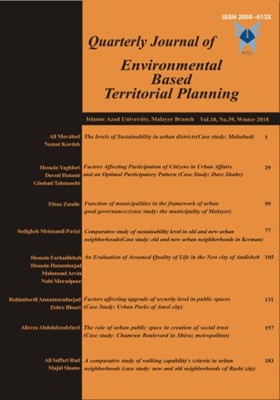A comparative study of walking capability’s level in the of urban neighborhoods.(A case study: criteriaof old and new neighborhoods in the city of Rasht)
Subject Areas :ali saffarirad 1 * , majid shams 2
1 - Ph.D. Geography and urban planning, Islamic Azad University, Malayer Branch
2 - Ph.D. Professor of Geography and urban Planning, Islamic Azad University, Malayer Branch
Keywords: Guilan Province, Rasht City, urban neighborhoods, Walking capability, standard rules,
Abstract :
Abstract Walking and enhancing walkability in the neighborhood areas may lead to increase security and social relations, accesses, neighborhood identity, the sense of community, neighborhood quality and to reduce environmental quality such as noise and air pollution.This study was to answer the question thathow the walking capability is in the city of Rasht in Guilan. In terms of practical goal, descriptive_ analytical essence, and data collection the current study is on the basis of library research and field work.For this purpose, first walking capability indicators of old and new communities were investigated. Each was compared by standard rules then optimal strategies to improve the walkability of aforementioned areas were presented. Residents of 5 new and 5 old neighborhoods that have a population of 124382 thousands were selected as a statistical society. By using Cochran formula a sample of 366 residents out of population were reselected. In this regard, because of the proximity of the number of new (61722 people) and old communities (62660 people), 183 questionnaires in new and 183 questionnaire in old neighborhoods were completed. In order to understand the gap between studied indices of residents of new and old neighborhoods, due to the nature of interval data, an independent T-Test was used. T-Test results determine that in many of the components between the two communities (respondents) there is a significant difference. In general it can be claimed that according to the field studies, as well as respondents new neighborhood in most cases than the old ones have better conditions in terms of walking capability. Keywords: Walking capability,urban neighborhoods, standard rules, Guilan province, Rasht city.
1. اپیلیارد، د، 1382، خیابان ها می توانند باعث مرگ شهرها شوند (رهنمودهایی برای طراحی خیابان در شهرهای جهان سوم) ، ترجمه: نوین تولایی، فصلنامه آبادی، شماره 39، 31-17.
2. اصغر زاده یزدی، س، 1388، اصول پیشنهادی نوشهرگرایی در برنامه ریزی محله های شهری، مجله مسکن و محیط روستا، شماره 25، سال ششم، 63-50.
3. افشاری آزاد، م و پورکی، ه، 1390، مورفولوژی شهری و آب گرفتگی معابر شهر رشت، فصلنامه آمایش محیط، شماره 17، سال پنجم، 40-25.
4. پاکزاد، ج، 1385، راهنمای طراحی فضاهای شهری در ایران، وزارت مسکن و شهرسازی، معاونت شهرسازی و معماری.
5. ترکاشوند، ع، تیراندازیان، م و غلامرضائی، ح، 1394، ضوابط شهرداری ها برای طراحی معابر، پیاده رو ها و پارکها، چاپ اول، انتشارات کلهر.
6. تقوایی، مسعود و خمسلویی، علی، 1391، بررسی آسیب پذیری کاربری های شهری در مسیرهای راه پیمایی با رویکرد پدافند غیر عامل مطالعه موردی: کلان شهر اصفهان، فصلنامه آمایش محیط، شماره 16، سال پنجم، 142-125.
7. حسینی، س ع، بهرامی، ی و قادری مطلق، ا، 1392، تحلیل تأثیر عملکردهای محله ای بر رفتار سفر شهروندان( مورد مطالعه: شهر رشت)، پژوهش های جغرافیای انسانی، دوره 46، شماره 3، 676- 657.
8. سازمان مدیریت و برنامه ریزی استان گیلان، 1390، نتایج تفصیلی سرشماری عمومی نفوس و مسکن، معاونت برنامه ریزی – دفتر آمار و اطلاعات.
7. سبز علی یمقانی، ع و آل شیخ، ع، 1394، توسعه و ارزیابی یک شاخص قابلیت پیاده روی(مطالعه موردی: محلات شهر قم)، نشریه علمی – پژوهشی علوم و فنون نقشه برداری، دوره پنجم، شماره 1، 159- 174.
8. سازمان جغرافیایی نیروهای مسلح، 1395.
9. صرافی، م، محمدیان مصمم، ح، 1391، پیاده راه سازی خیابانهای مرکز شهر همدان، فصلنامه آمایش محیط، شماره 21، سال ششم، صص 138-111.
10. معینی، س م ، 1385، افزایش قابلیت پیاده مداری، گامی به سوی شهری انسانی تر، نشریه هنرهای زیبا، شماره 27، 16-5.
11. مهدیزاده، ج، 1378، مفاهیم و مبانی پیاده راه سازی، ماهنامه شهرداری ها، شماره 19، سال پنجم، 18-12.
12. نیکویه، م، 1387، رشت شهر باران، مرکز پژوهش های شورای اسلامی شهر رشت، نشر ایلیا.
13. Brown et al.2007, Walkable Route perceptions and physical features. Environment and Behavior Journal 39 (1); 34-61.
14. Brown et al, 2007, "Walkable Route Perceptions and Physical Feattures". Environment and Behavior Journal 39(1):34-61.
15. Cowan, R., 2005, The Dictionary of urbanism, Streetwise press Ltd, London.
16. Hikichi, Lynda,2003," New urbanism and transportation".www. Newurbanism. org.
17. Nosal,Bob Halton , 2009, " Creating Walkable and Transit – Supportive Communities in Halton" Region Health Department of Halton Department of Halton University.
18.Qureshi,I.A, and Iu, H.2007, Urban transport and sustainable transportaition strategies: A Case Study of Karachi, Pakistan. TsinghuaScience and Technology 12.
19. Revell, John,2007, making Canada's city more livable: the success of new urbanism depends on parking planning.

